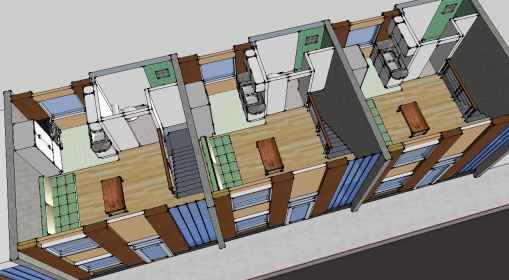The Workantile Phone Booth project has tapered off as an unrefined but mostly-finished thing. I haven’t been spending as much time at Workantile for the past couple months as I would like, so it’s not something I’ve done much with since finishing building it. But, a couple things have prompted thinking about this right now.
A recent email from someone who is part of a co-working startup asked a few questions about the project, since they are going through the same questions for their space. The whole issue of phone rooms and privacy is something under discussion at Workantile right now, as well, as we contemplate building a couple more phone rooms into the space. So it’s time to revisit the topic for a couple of different reasons.
At Workantile, the lack of enough spaces for phone calls is rising to problematic levels. More and more members want to have spaces where they can make and receive phone calls with some privacy and without disrupting everyone else. The “conference rooms” (there is a smaller one – roughly 12′ x 8′, and a larger one – roughly 16′ x 10′) are most often seemingly used by single individuals on conference calls or the like. Very few conferences actually take place at Workantile.
We have begun talking about doing an internal fundraiser for some renovations to improve this. The current proposal is to carve out two additional small phone rooms out of the large conference room and to divide the current phone room ( which is roughly 5′ x 8′) into two smaller rooms.
We seem to be favoring hard construction instead of phone booths as a solution for our need for more private conversation areas in the space. The sketch below shows how we are planning to revise the space.

This isn’t phone booths. This would be building new walls and creating new, little rooms people could sit in for phone calls. But how did we end up here?
The discussion about the phone booth started when a couple of the Maintainers saw an old, wooden phone booth in a nearby sports bar, and wondered about building something like that for Workatile. This led to me looking at phone booths and starting to design the Workantile Phone Booth.
I also quickly settled on wanting to develop a design that could be a kit that could be assembled as an IKEA-like project.
There were a couple different materials I looked at. I was initially very interested in using metal for this, but the fabrication costs were extremely high. Wood is more workable and more adaptable by others, so that seemed like the better option. Even if it was a completely worked-out kit, people will want to make changes and modifications, and the wood option works better for that.
The first phone booth has been built. Doing the fabrication with the ShopBot was a great experience. I got to use our local maker-space, Maker-Works, to build this. The pattern on the sides (an interpretation of the Workantile logo checker-plate pattern with holes) was something that could only have been done with the ShopBot, and I like the detail and fitting of the corners on the box.
After looking at a number of possibilities, the best idea for a door seemed to be a heavy cloth curtain. That would do more to muffle sound than any kind of hinged door, and the construction would be simpler and less expensive, too. At the moment, though, the only curtain is a thin, single sheet of material we found during cleanup a while back. Adding a door and hinge is something that can be added, but the curtain would be cheaper and easier for a first version.
Some things remain unfinished. The full number of screws haven’t been installed, and instead of putting a continuous base in place, I just used a couple of blocks, since it if needed to be broken down or moved it would be easier with fewer fasteners in place. But, it’s finished, at least as version 1.0, and it’s available for use.

So, what’s wrong with phone booths?
Firstly, let me say I think phone booths can – and do – work, but they have to be used in appropriate places and in appropriate ways.
 A couple of Workantile members found an old therapy chamber at the University’s Property Disposition, and that serves as a phone booth for the upstairs Loft area (photo by Brendan Chard). That works for short calls, but gets uncomfortable after more than a few minutes. Since this was originally a 6-figure piece of medical equipment (picked up for under $100), it is pretty airtight, and that helps limit sound transmission, so it’s noticeably quieter than if someone outside the booth is talking at similar volume. Airtight is good to prevent sound transmission, but it’s not very comfortable.
A couple of Workantile members found an old therapy chamber at the University’s Property Disposition, and that serves as a phone booth for the upstairs Loft area (photo by Brendan Chard). That works for short calls, but gets uncomfortable after more than a few minutes. Since this was originally a 6-figure piece of medical equipment (picked up for under $100), it is pretty airtight, and that helps limit sound transmission, so it’s noticeably quieter than if someone outside the booth is talking at similar volume. Airtight is good to prevent sound transmission, but it’s not very comfortable.
Thinking about the acoustics, a phone booth for a coworking space or an office of any kind is fundamentally the exact opposite of a traditional phone booth. The idea wasn’t to keep inside noise from getting out, but to keep outside noise from getting in.
The classic 1950s phone booth was something located on a busy, noisy streetcorner. The soundproofing it provided (to the extent that it did any) was to keep the outside noise from reaching the inside. You needed some noise reduction to be able to hear the person at the other end over the background noise that was around you. Muffling that noise and lowering it somewhat makes it easier to hear the other end and to have them be able to hear the person in the phone booth more clearly. That’s how it works in the sports bar, as well. It’s an oasis of relative quiet in an otherwise noisy place.
A phone booth in an office or in a co-working space is the exact opposite. It’s a fundamentally quiet space. The person having the conversation is far louder than background, even if they are talking quietly. Someone talking in the space is a noise mountain in an otherwise silent desert. If they are in a phone booth, it’s reduced somewhat, but it’s still the biggest thing in the area. That calls for it to be a completely different thing.
For acoustic separation, background noise actually helps. If there is enough other activity in the space, other conversations are going on, background music is playing, etc., then the phone booth works better, since it can drop the noise level to a point closer to other noise in the area, and the conversation is not dominant. But when there are just a few people all diligently working heads-down on their own projects and someone gets a call, it’s a huge spike in the noise level in the space.
One of the things I’ve suggested for the new phone rooms is to install bathroom-type vent fans in each of them. While this was originally an idea to reduce the cost and difficulty of getting ventilation ductwork (which might not work especially well, in any case) to these small spaces. But, in addition to circulating air, the right fan will make enough white noise to help obscure some of the voices in the area.
The fundamental problem with the phone booth is that it doesn’t do enough (and probably can’t do enough, in any comfortable fashion) to knock down the noise level of a conversation in an otherwise quiet room.
Three things help with noise reduction: separation (barriers), distance, and masking (other sounds). If conversation is 60 dB, and the space is otherwise library quiet (40 dB), that conversation is 4 times as loud as the background sound level. Even with really good construction that cuts noise in half (which would make it 50dB), it’s still going to be twice as loud as the background. Short of heroic measures (which would be both costly and unwieldy), a ‘Cone of Silence’ solution is unlikely.
So then, what should be done? The barrier helps, but only somewhat. Having more background sound will help to make other people’s conversations less obtrusive. At Workantile, there is an AirPlay system in place that anyone on the network can tap in to (if they have an iTunes account) and play music over the speakers. And when the place is busier, with people talking and moving around, that helps, too.
The other thing is to move the phone booth out of the main work space. Getting phone calls out of proximity to quiet work areas can also help make phone conversations less of a distraction to other people in the space.
(The fact that Workantile is a very ‘live’ space with two large brick walls, a hardwood floor and ceiling, is a further complication to all of this, but that’s a whole separate topic for another time.)
The Workantile Phone Booth needs to be relocated to a more appropriate location; that has been held up in large part due to the art show that is on the walls right now. If it was near the Kitchen (red square on the plan above), it would be by a spot that no one spends a great deal of time (unless they are using the sink, which provides fantastic white noise).
A phone booth can transform an otherwise under-used area into a phone space. The Kitchen nook isn’t a good phone space as it currently is, because it’s also a hallway and too many people go through it for it to be a comfortable phone space. But it’s away from the other work areas, and it could be a place where one might take a shorter phone call. Right now, though, it doesn’t seem appropriate to stand in the Kitchen area to do that. The phone booth could make a space in an area that otherwise serves another purpose, so that someone could have a conversation on the phone with less worry about disrupting the rest of the space.
Think again of the 1950’s phone booth on the street corner. It takes a public area (much like the hallway and kitchen nook at Workantile) and carves out a small space for a more private conversation to take place in the midst of that. In this way, the phone booth is as much (or more) a social marker than it is a technical solution to noise. It’s a way of making it comfortable for a person to have their conversation in what would otherwise be an uncomfortable place.
Neither hard constructed rooms nor phone booths are going to be the perfect solution for all phone privacy needs. Both options have their place, and each has benefits and disadvantages.












